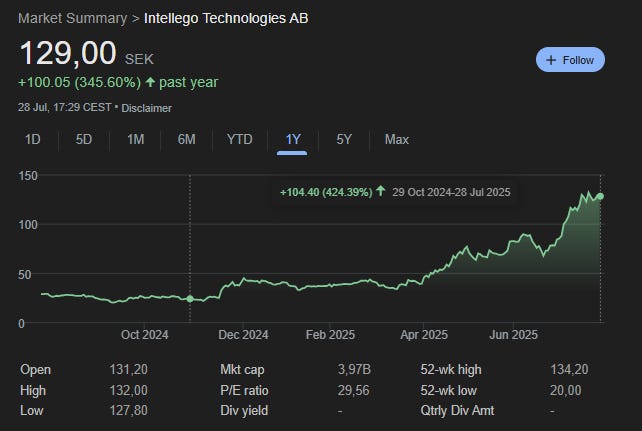Ondo Insurtech, 100-Bagger Math. 800M ARR. £30M Cap
A +50 Page Deep Dive into the Most Asymmetric Investment Setup I’ve Found This Year
Today I’m presenting a tiny £33 million company that could grow into a massive market. Based on current contracts alone, this business has an addresable market to reach +£800 million in ARR. Yet, it remains deeply undercovered, trading at just 5.5x current ARR. Positioned for over 100% growth over the coming years, this is one of the most asymmetric opportunities I’ve seen in a while.
With catalysts in place, it could perform strongly in the short term—but the long-term potential is where the real upside lies. The addressable market is enormous, the execution is sharp, and this company could plausibly become a 100-bagger. The business model is so compelling that it has become my latest obsession. I’ve been working day and night to publish this ahead of tomorrow’s earnings, which may present an attractive short-term entry.
It reminds me of Intellego, a stock that has returned more than 5x since I first covered it nine months ago. Intellego unlocked growth once it figured out its sales model. This company has just solved both its financing and sales friction, and I believe we’re about to witness a similar inflection.
*Intellego since I covered it.
In a sector where most IoT ventures have failed to scale—either collapsing under high hardware costs, poor customer engagement, or lack of insurer buy-in—this company stands out as a rare exception. It offers a patented, insurer-funded technology (the customer gets it 100% for free) that directly targets the largest cause of non-weather property insurance claims: water damage. What sets this business apart is its ability to address every pain point that has sunk previous players in the space. It avoids consumer friction by working through insurance companies, offers a hardware + service solution with free plumbing repairs to homeowners, and charges insurers via recurring SaaS-style subscriptions, some of which are now being paid upfront to finance expansion at no dilution.
Customer engagement is outstanding, with a Net Promoter Score of +80 and an average user rating of 4.93/5. The tech works—and the customers love it. Financially, it is nearing a turning point. The company crossed £5.9 million in annual recurring revenue this past year, with huge year-on-year growth and increasing gross margins that now reach ~49% in its home market (they should reach 70-80% post product deployment). It has scaled production from 10,000 to 40,000 units per month, with no need for major capital expenditure, and expects to reach EBITDA profitability by 2026.
More importantly, the U.S. expansion is now fully underway. After years of testing with top carriers, the company has entered full rollouts across 23 states, supported by major insurer partners covering over 14 million homes. These include multiple top-tier homeowner insurers who have extended programs or signed on in the last 6 months.
Despite all of this, the business remains largely undiscovered. It went public via an obscure vehicle, trades on a secondary exchange with limited liquidity, and is still priced at a fraction of what its ARR or U.S. contracts would imply. Recent share price pressure following a strategic pivot—from signing more contracts to scaling penetration within them—has created a unique setup: a company leaving its startup phase behind, with major contracts secured, and now focusing on execution.
The reasons why this company is overlooked are clear. It went public through a SPAC, which many investors ignore. Most contenders in this space failed. It’s small, trades on the secondary market in London, and nobody is paying attention. But behind this we could be looking at a business with enviable margins, recurring revenue, and a strong competitive position.
Top insurers are now paying upfront, reducing capital risk and improving cash flows. There is proven cost savings for insurers from reduced claim frequency and severity. The company faces minimal credible competition. It shows strong customer retention, satisfaction, and pricing power already in early U.S. cohorts.
Inside This +50 page report (Paywalled):
Business model
Deep-dive: Why the product works when others didn’t
Competitive analysis: 7 rivals dissected
Unit economics and margin evolution
Full partnership map and rollout status
Headcount, financials, and funding history
How production scaled and what it cost
Short term opportunity and catalysts
3-year valuation models (bull, base, bear)


